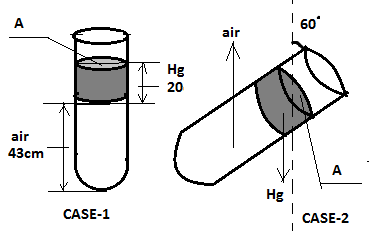
An ideal gas is trapped between the mercury column and the closed end of a narrow vertical tube containing the column. The upper end of the tube is open to the atmosphere. The atmospheric pressure is equal to 76cm of Hg. The lengths of mercury column and trapped air column are 20 cm and 43 cm respectively. What will be the length of the air column if the tube is tiled in the vertical plane with an of ${60^ \circ }$? Assume the temperature to be constant.
Answer
218.4k+ views
Hint: In this question we have to do the analysis of pressure at the bottom of the flask. Doing so in the two given conditions will give us the new length of air columns.
Complete step by step solution:

Case 1: Before tilting;
Let the pressure of trapped air be ${P_1}$
This will be the pressure at the air-mercury interface.
Also atmospheric pressure ( ${P_0}$ ) = 76 cm of Hg.
Now at point on the air-mercury interface the pressure will be;
${P_0} + {P_{Hg}} = {P_1}$
${P_1} = 76 + 20 = 96$ (Equation: 1)
Now since air is an ideal gas it will have uniform pressure throughout it. So the pressure at the bottom of the flask will be ${P_1} = 96$
Let the area of the tube be A
So applying gas law we get;
${P_1}V = nRT$
Now we all know, $V = Al$
And $l = 43cm$
Thus $ \Rightarrow 96(A \times 43) = nRT$ (Equation: 2)
Now let us consider case 2 (after tilling);
The pressure at the air mercury interface ( ${P_2}$ ) is given by;
${P_2} = {P_0} + {P_{Hg}}\cos ({60^ \circ })$
Thus, $ \Rightarrow {P_2} = 79 + \dfrac{{20}}{2} = 86$
Now applying gas law we get;
${P_2}V = nRT$
$ \Rightarrow 86(Al') = nRT$ (Equation: 3) (here, $l'$ is the new length of air column)
From equation 2 and equation 3 we get;
$ \Rightarrow 96 \times 43A = 86Al'$
$\therefore l' = \dfrac{{96 \times 43}}{{86}} = 48cm$
Therefore, the new length is 48 cm.
Note:The volume is changing and hence the area is constant.
If the lid will be closed the volume won’t change and hence the area will change.
The pressure balancing should be done carefully.
Complete step by step solution:

Case 1: Before tilting;
Let the pressure of trapped air be ${P_1}$
This will be the pressure at the air-mercury interface.
Also atmospheric pressure ( ${P_0}$ ) = 76 cm of Hg.
Now at point on the air-mercury interface the pressure will be;
${P_0} + {P_{Hg}} = {P_1}$
${P_1} = 76 + 20 = 96$ (Equation: 1)
Now since air is an ideal gas it will have uniform pressure throughout it. So the pressure at the bottom of the flask will be ${P_1} = 96$
Let the area of the tube be A
So applying gas law we get;
${P_1}V = nRT$
Now we all know, $V = Al$
And $l = 43cm$
Thus $ \Rightarrow 96(A \times 43) = nRT$ (Equation: 2)
Now let us consider case 2 (after tilling);
The pressure at the air mercury interface ( ${P_2}$ ) is given by;
${P_2} = {P_0} + {P_{Hg}}\cos ({60^ \circ })$
Thus, $ \Rightarrow {P_2} = 79 + \dfrac{{20}}{2} = 86$
Now applying gas law we get;
${P_2}V = nRT$
$ \Rightarrow 86(Al') = nRT$ (Equation: 3) (here, $l'$ is the new length of air column)
From equation 2 and equation 3 we get;
$ \Rightarrow 96 \times 43A = 86Al'$
$\therefore l' = \dfrac{{96 \times 43}}{{86}} = 48cm$
Therefore, the new length is 48 cm.
Note:The volume is changing and hence the area is constant.
If the lid will be closed the volume won’t change and hence the area will change.
The pressure balancing should be done carefully.
Recently Updated Pages
Chemical Properties of Hydrogen - Important Concepts for JEE Exam Preparation

JEE General Topics in Chemistry Important Concepts and Tips

JEE Atomic Structure and Chemical Bonding important Concepts and Tips

JEE Amino Acids and Peptides Important Concepts and Tips for Exam Preparation

JEE Extractive Metallurgy Important Concepts and Tips for Exam Preparation

Algebra Made Easy: Step-by-Step Guide for Students

Trending doubts
JEE Main 2026: Application Form Open, Exam Dates, Syllabus, Eligibility & Question Papers

Derivation of Equation of Trajectory Explained for Students

Hybridisation in Chemistry – Concept, Types & Applications

Understanding the Angle of Deviation in a Prism

Understanding Collisions: Types and Examples for Students

Understanding Atomic Structure for Beginners

Other Pages
JEE Advanced Marks vs Ranks 2025: Understanding Category-wise Qualifying Marks and Previous Year Cut-offs

Units And Measurements Class 11 Physics Chapter 1 CBSE Notes - 2025-26

NCERT Solutions For Class 11 Physics Chapter 8 Mechanical Properties Of Solids

Motion in a Straight Line Class 11 Physics Chapter 2 CBSE Notes - 2025-26

NCERT Solutions for Class 11 Physics Chapter 7 Gravitation 2025-26

How to Convert a Galvanometer into an Ammeter or Voltmeter




